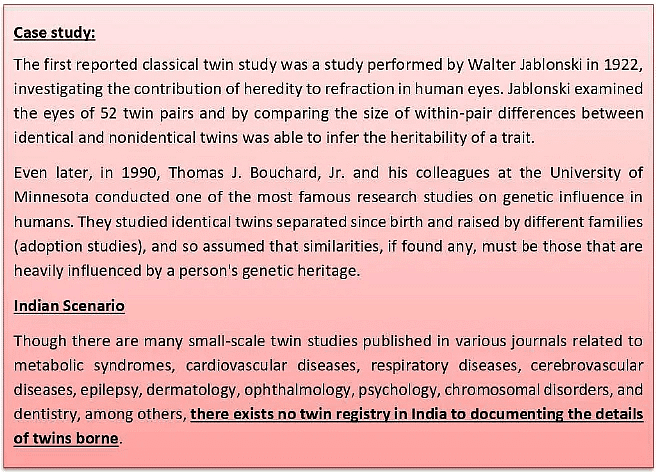Co-Twin Method | Anthropology Optional for UPSC PDF Download
Introduction
In twin method, the twins (MZ & DZ) are combined and studied in order to understand the influence of heredity & environment. However in co-twin method- identical twin along with its co-twin & fraternal twin along with its co-twin me investigated and compared.
Uses of Twin Study
- To estimate the role of hereditary & environment in the formation of character.
- Useful for drug testing trials in the treatment of disease- therapeutic trials.
- To study the mechanism of transmission of genetic diseases in the population.
- Twin study is very important in understanding behavioural genetics.
Issues with Twin study
- The twin study method does not specifically identify the genetic and environmental components of a trait, but rather observes the interaction between them. It does not pinpoint the nature, location, or behavior of specific genes, nor does it recognize the various aspects of the environment, such as its physical, chemical, or biological components.
- Complex traits, such as intelligence and behavior, are influenced by both genetic and environmental factors, making it difficult to quantify their individual contributions. The method assumes that monozygotic twins are exactly identical, but research has shown that they can differ in various characteristics, such as size and vigor.
- Furthermore, twin studies cannot be used to estimate the influence of the intrauterine environment or to analyze traits like congenital malformations. Many environmental factors remain unaccounted for and may be falsely attributed to genetics.
- Due to the nature of twin studies and the typically small sample sizes, it is challenging to quantitatively analyze the results, rendering most experiments observational rather than statistical. Additionally, the method does not account for variations between populations. A specific trait may differ in one population due to genetic reasons, while in another population, it may differ due to environmental influences.
- Twinning itself is a rare occurrence, which calls into question the generalizability of findings based on such studies. The twin study method also tends to assume that one gene affects one behavioral trait, while modern genetic research indicates that multiple genes can influence behavior. Overall, while twin studies provide valuable insights into the interaction between genetics and environment, they have several limitations that must be considered when interpreting their results.
Conclusion
Twin studies, including the co-twin method, are valuable tools for understanding the influence of heredity and environment on various traits, including behavioral genetics and disease transmission. However, these methods have limitations, such as not identifying specific genetic and environmental components, assuming monozygotic twins are identical, and not accounting for variations between populations. Twinning is also a rare occurrence, and the generalizability of findings can be questioned. Despite these limitations, twin studies provide essential insights into the complex interplay between genetics and environmental factors.
Frequently Asked Questions (FAQs) for Co-Twin Method
 |
Download the notes
Co-Twin Method
|
Download as PDF |
What is the main purpose of twin studies?
The primary purpose of twin studies is to estimate the role of heredity and environment in the formation of character, understand behavioral genetics, and study the mechanism of transmission of genetic diseases in the population. They are also useful for drug testing trials in the treatment of diseases - therapeutic trials.
What are the limitations of twin studies?
Limitations of twin studies include the inability to specifically identify genetic and environmental components of a trait, difficulty in quantifying the individual contributions of genetic and environmental factors for complex traits, the assumption that monozygotic twins are exactly identical, challenges in analyzing results quantitatively, not accounting for variations between populations, and the rarity of twinning, which questions the generalizability of findings.
How do co-twin studies differ from twin studies?
In co-twin studies, identical twins along with their co-twins and fraternal twins along with their co-twins are investigated and compared. This method differs from traditional twin studies, which combine and study twins (monozygotic and dizygotic) to understand the influence of heredity and environment.
|
108 videos|243 docs
|


















